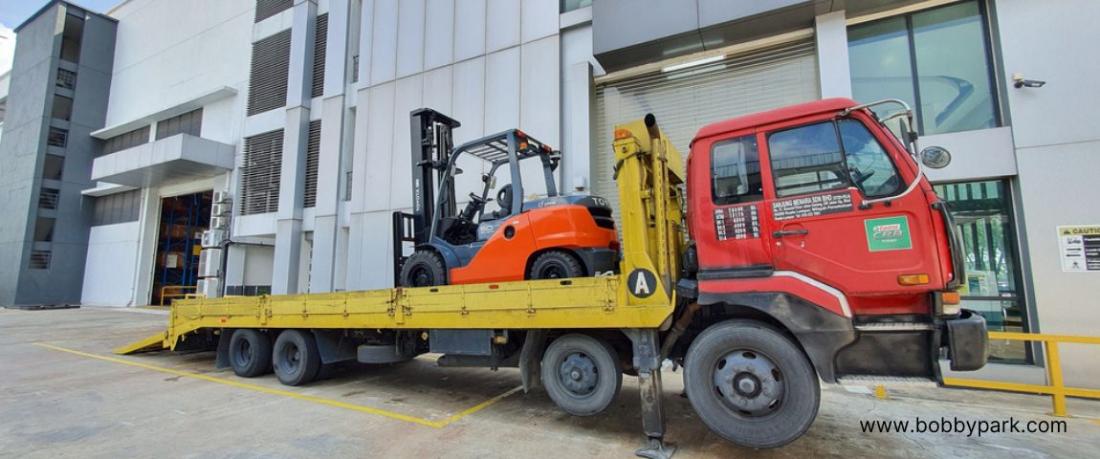HOW TO SECURE A FORKLIFT ON A FLATBED? THE COMPLETE INSTRUCTIONS

Transporting a forklift on a flatbed requires precision and knowledge to ensure the equipment and the vehicle remain safe during transit. This comprehensive guide walks you through the step-by-step process of forklift flatbed securing. We at Bobby Park Truck and Equipment cover everything from essential equipment to safety measures.
Essential Equipment for Forklift Flatbed Securing
Securing a forklift on a flatbed demands the right equipment. Forklift straps and chains, ratchet binders, and blocking materials are essential. These ensure stable and secure transport, guaranteeing both forklift and flatbed stay safe throughout the journey.
Forklift Straps and Chains
Forklift straps and chains are the backbone of a secure transportation process. Ensure they are made of high-quality materials and have the appropriate weight-bearing capacity.
Ratchet Binders and Tensioners
These tools are crucial for tightening straps and chains securely. Choose heavy-duty ratchet binders that can withstand the weight of the forklift. You can get information about these materials from our website of used truck dealers.
Blocking and Bracing Materials
Wooden blocks and bracing materials help prevent the forklift from shifting during transit. They create a stable foundation, adding an extra layer of security.
How to Properly Secure a Forklift?
When it comes to transporting a forklift on a flatbed, proper securing is paramount. This section will outline the step-by-step process to ensure your forklift is securely fastened, minimizing risks and ensuring a smooth journey. A used commercial truck dealer will provide the proper guidelines for safe forklift securing.
Step 1: Positioning
Drive the forklift onto the flatbed and position it to align with the vehicle's center of gravity. This ensures an even distribution of weight.
Step 2: Attach Straps and Chains
Begin by attaching the straps or chains to the designated anchor points on the forklift. Cross them for added stability and hook them onto the flatbed's anchor points.
Step 3: Tighten and Tension
Tighten the straps or chains using ratchet binders until there's no slack. Be sure not to over-tighten, as this could cause damage to the forklift.
Step 4: Blocking and Bracing
Place wooden blocks and bracing materials around the forklift's wheels to prevent lateral movement. This additional measure ensures the forklift remains in place.
Safety Measures for Transporting a Forklift by Used Trucks Dealer
Prioritizing forklift safety measures is paramount when transporting a forklift. This section delves into crucial measures experts at Bobby Park Truck and Equipment explain to ensure a secure journey. From inspecting straps and chains to maintaining tire pressure, these steps are vital for smooth and accident-free transportation.
Inspect Straps and Chains
Before departure, thoroughly examine all straps and chains for signs of wear or damage.
Check Tyre Pressure
Ensure forklift tyres are properly inflated to prevent shifts in weight during transit.
Smooth Driving
Maintain a steady pace and avoid sudden stops to prevent the forklift from shifting forward.
Regular Inspections
Routinely check straps and chains for wear, tear, or damage before each journey.
Immediate Repairs
If you notice any damaged straps or chains during transit, stop and replace them promptly.
Secure Blocking and Bracing
Ensure wooden blocks and bracing materials are in place to prevent lateral movement.
Mastering the art of forklift flatbed securing is crucial for anyone in the logistics industry. Following the steps outlined in this guide by trusted truck dealers and adhering to safety measures can ensure a smooth and secure transportation process.
Below are some important questions that business owners should ask about securing a forklift on a flatbed truck.
Frequently Asked Questions
Q1: Can I transport a forklift without straps or chains?
Using straps or chains is crucial for forklift flatbed securing. They provide the necessary stability during transit. Ignoring this security measure can be the cause of serious accidents.
Q2: What should I do if a strap or chain is damaged during transit?
If you notice any damage, it's imperative to stop and replace the damaged strap or chain immediately. Continuing the journey with compromised equipment can lead to accidents. Drivers can keep extra chains and straps when going on a journey.
Q3: Is it necessary to cross the straps or chains?
Crossing the straps or chains creates a crisscross pattern that enhances stability and prevents lateral movement.
Q4: Can I transport a forklift on a flatbed without blocking and bracing?
Blocking and bracing are other essential safety measures to prevent the forklift from shifting. Skipping this step could lead to accidents and damage.
Q5: How often should I inspect the straps and chains?
Before every journey, inspecting the straps and chains for any signs of wear, tear, or damage is crucial. This inspection should be in the top five numbers of the list.
Q6: What if the forklift's tires are under-inflated?
Under-inflated tires can lead to shifts in weight during transit. Ensure the tires are properly inflated before securing the forklift.
WHY CHOOSE US?
- Full Parts and Service Shop
- State of the Art Paint Shop
- Body Work
- Van bodies, reefer bodies, Flatbed bodies and Storage Containers available
- Tuscaloosa and Jackson Locations
- Ships anywhere in the United States

